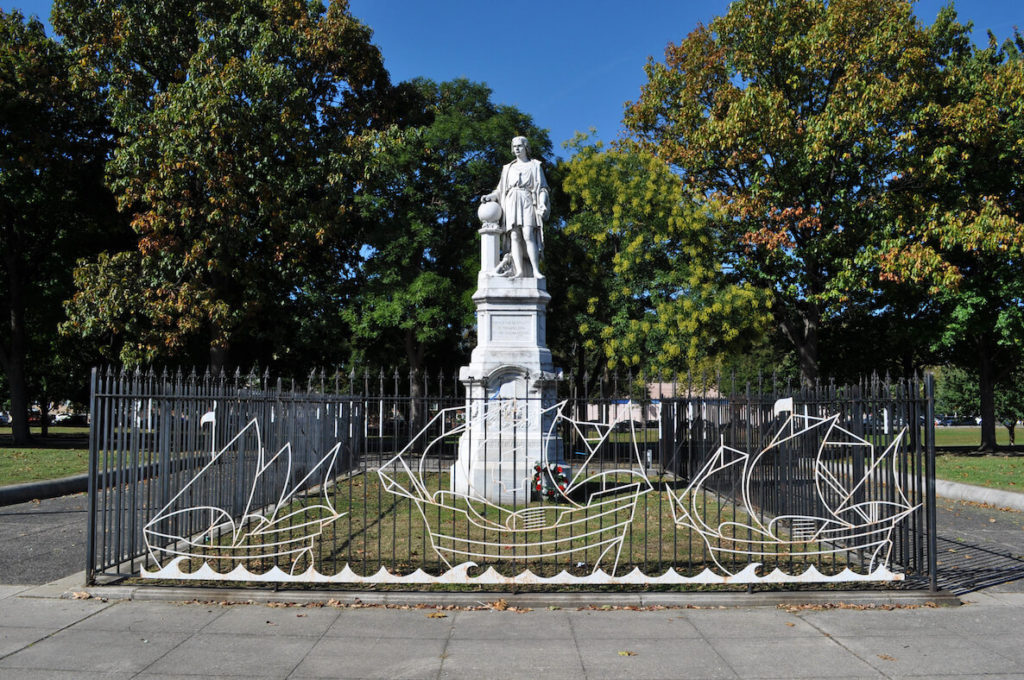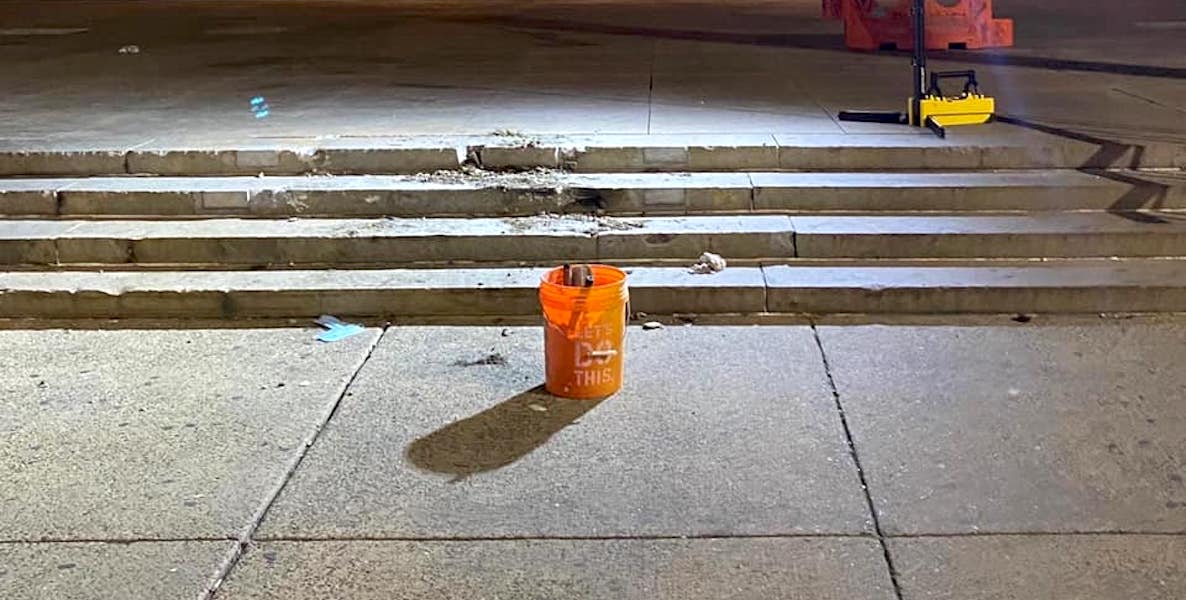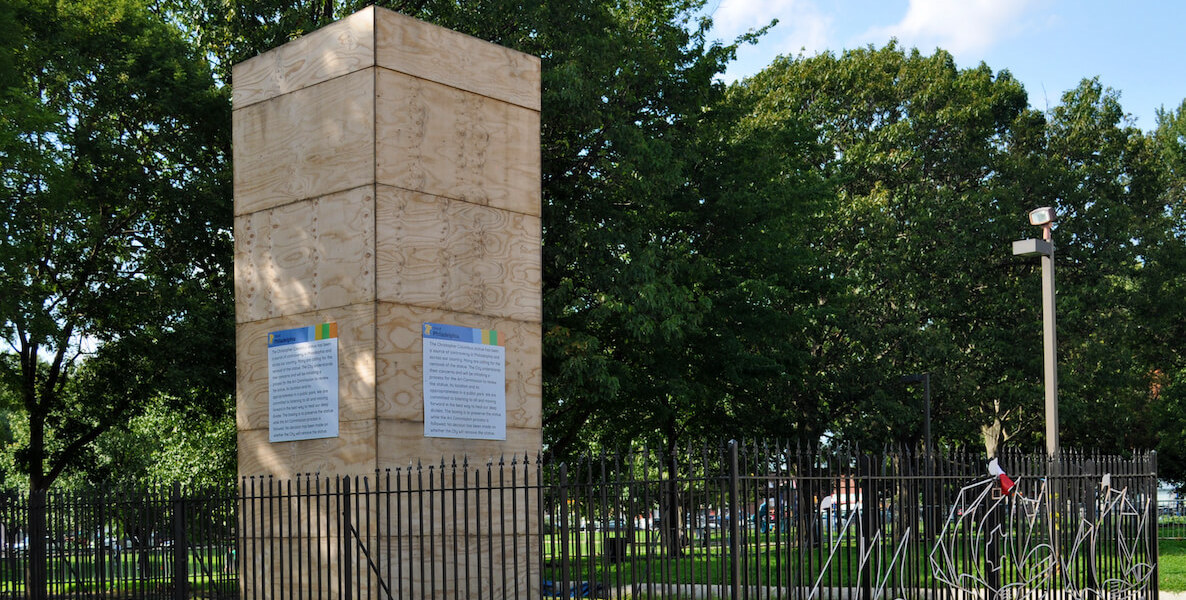Have you been following the fight over the South Philly statue of Christopher Columbus? It’s about much more than a statue. It’s a metaphor for how we talk past one another these days, how our public conversation gravitates toward more heat than light, how argument by proxy has become the order of the day, how the Overton window of public discourse has left no room for nuance or complexity.
It’s also—in its dueling urges to shut up, or cancel, the other side—a precursor of ever more political polarization in our future. Make no mistake: The progressive rush to “cancel” Columbus just might be the seeds of the Democrats’ shellacking in the mid-term elections a year from now.
Make no mistake: The progressive rush to “cancel” Columbus just might be the seeds of the Democrats’ shellacking in the mid-term elections a year from now.
First, the background: Last Saturday, in advance of the holiday, Common Pleas Judge Paula Patrick issued a ruling that would allow a contractor to remove the plywood box that has been covering the statue since the protests in the aftermath of the George Floyd murder last summer. Mayor Kenney had sought to remove the statue as a matter of public safety, he claimed. Patrick, however, called the confrontations that had taken place between Columbus protestors and defenders of the statue “isolated civil unrest” and called the City’s decision to remove the statue “baffling” and unsupported by the law.
Patrick was right to conclude that this was about much more than public safety. Kenney had earlier signed an executive order changing the name of the city’s annual Columbus Day holiday to Indigenous Peoples Day, citing Columbus’ “infamous history,” and Monday of this week was the first city holiday under the new name.
So the stage has long been set: Progressives, aghast at Columbus’ barbaric treatment of Native Americans, on one side; Italian-American residents for whom Columbus’ historic voyage presaged the brave search for a new world undertaken by their very ancestors, on the other. How could this not get personal?
Saturday night, Commonwealth Court intervened, vacating Patrick’s order in response to an emergency petition filed by the Kenney administration. So the stalemate continues, and the Columbus statue remains covered pending consideration by the Commonwealth Court of the full issue. But the rhetoric is still hot.
RELATED: Confronting our past helps us reckon with the present
“The time and energy Mayor Kenney is devoting to the removal of a statue doesn’t do one thing to help combat gun violence,” says George Bochetto, the famously pugilistic attorney representing the South Philly residents who want to free the statue. “Not one thing to help our education system. Not one thing to uplift our poverty rate. It’s wasted energy and a grudge match against the Italian-American community. Any sensible thinking person looks at this and says, What’s going on here? Why are we spending time and energy on this?”
I’m not so sure this is a case of anti-Italian-American bias, though there’s no denying ideology is omnipresent in this story. It just may be that Kenney is kowtowing to his progressive base, and that the ever-thin-skinned mayor is driven by personal animus for one of the leaders among Bochetto’s brigade, former state senator and convicted felon Vince Fumo. He was once Kenney’s mentor and the two have had a Shakespearean falling out.
Whatever the behind-the-scenes psychodrama, Bochetto is on to something with his second point. All the shouting, all the charges and counter-charges, and, especially, all the urges not to engage in reasoned debate but to shut up those of opposing views and literally disappear artifacts of distasteful history only serves to further alienate the average citizen and voter.
Rather than trying to cancel and disappear each other, how about listening to one another? That’s what Bochetto was seeming to get at on Saturday. “Why can’t they put up another statue right here to honor Indigenous People?” he told the Inquirer. “You let everybody celebrate their ethnicity.”

Four years ago, that was my position when it came to the Rizzo statue. Rather than pretend that the divisive mayor never existed, I wrote, how about stationing the statue of martyred civil rights leader Octavius Catto right near it, a “signifier to all that our city, the birthplace of American democracy, recognizes that we’re in an ongoing conversation, messy though it is, in pursuit of that ever-elusive more perfect union”?
“That’s exactly right,” Bochetto says. “Yes, Rizzo was an animal in certain respects. But it’s important that that message is out there so we become a better society. The same is true of Columbus.”
We’ve become incapable of holding competing thoughts in our heads at the same time. Yes, Columbus was a marauder who—in direct contradiction of his orders from King Ferdinand and Queen Isabella to “treat the Indians very well and lovingly”—committed acts of savagery and had considerable amounts of blood on his hands. And, yes, if not for the voyage of this deeply-flawed human being, we might just not have western civilization as we know it. Those shouldn’t be irreconcilable facts.
RELATED: Let’s replace Columbus statue with one of Caroline LeCount
“There is no doubt that Columbus was a man of enormous flaws,” writes the Boston Globe’s Jeff Jacoby. “He was a zealot, greedy and ambitious. He was capable of cruelty and deception…But not even Columbus’s most implacable bashers can deny that he was a history-changing mariner of incomparable skill—a self-taught genius of towering valor and grit, who was seized by an unshaken, audacious conviction that he could reach the East by sailing west. Columbus propelled the human story forward as few men or women ever have. If his shortcomings were enormous, so were his achievements, for it was he who sowed the seeds of Western civilization in the New World, [among them] the very concepts of human rights, natural law, justice, and morality that Columbus and the Europeans who followed him are condemned for violating.”
Jacoby doesn’t let Columbus off the hook—and nor did his patrons, who charged and imprisoned him for his barbarous treatment of Native Americans. But he reminds us that Columbus “introduced Christendom to a previously unknown continent, and in so doing, eventually drove the Church to declare that American Indians were, like Europeans, human beings created in God’s image.” Jacoby’s Columbus argument is the same as that made by none other than Barack Obama, who noted that Columbus’ voyage “changed the trajectory of our world.” In other words, it’s what Columbus unlocked—radical Western ideas like justice—that ought to be celebrated, not the man or his actions.
Earlier this week, in the pages of The Wall Street Journal, Alessandro Bocchi took the argument one step further in a piece headlined “Columbus Day Stands for Diversity.” Calling Columbus a “flawed man who symbolizes a minority’s triumph over discrimination,” she argues that Columbus “stands for the idea that America wasn’t built only by Protestants of British descent but by people from a variety of nations, religions and cultures. Columbus paved the way for the inclusion and diversity that is unique to the New World.”
All the shouting, all the charges and counter-charges, and, especially, all the urges not to engage in reasoned debate but to shut up those of opposing views and literally disappear artifacts of distasteful history only serves to further alienate the average citizen and voter.
It’s a provocative idea, and one that surely would raise the ire of the progressive protestors calling for the disappearance of the South Philly statue. But, really, what has whitewashing ever gotten anyone? I know I’ve never persuaded a fellow countryman to my point of view by insisting on erasing parts of our shared history.
Which is why Bochetto is on to something. How about side-by-side statues in South Philly? One that could present Columbus in context—the criminal misdeeds alongside the lofty principles his voyage unlocked, something all Americans, and not just those of Italian descent, ought to be proud of. And, right next to that, a statue that honors Indigenous Peoples, their sacrifices, victimhood and rich culture throughout the ages.
How about, in other words, lowering the rhetoric and agreeing on an underlying basic set of facts? If we do that, we’ll be closer to being one people again—not matter what you chose to call the holiday.
![]()
RELATED
Ideas We Should Steal: Swap Columbus Day for an Election Day Holiday
Photo by N Giovannucci / Wikimedia Commons





